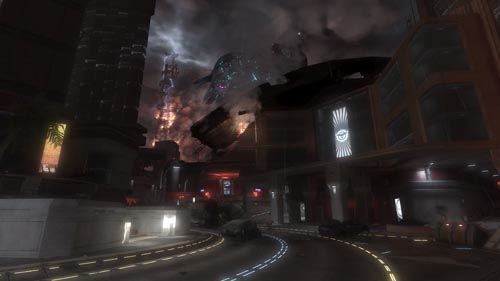I'll admit right here and now that the Halo franchise is one of my favorite franchises in gaming. I was hooked from day one when the original was released, as I spent an entire weekend playing it in co-op with my college roommate. Now we've arrived at our fifth Halo title, and the fourth shooter in the series with Halo 3: ODST, and while Master Chief's story may have come to an end there's still plenty of lore left in the Halo universe. But like many, I was a bit skeptical as to whether or not a change in characters and formula would work.
ODST takes place between Halo 2 and Halo 3. The Covenant have just discovered Earth and are looking for something deep within the planet. As the ODSTs are dropped into action a Covenant cruiser suddenly makes a slip space jump right in the middle of the mega city of New Mombasa. The five ODSTs in our story are scattered throughout the city as a result, and you as the nameless Rookie must piece it all back together. You'll work through a darkened and wrecked city in the middle of the night finding clues to your squad's whereabouts. With every piece collected, you'll trigger a new flashback and a small scenario is played out. Bungie has touted the game as more opened ended, and to some degree its true. You can walk around the city exploring areas and unlocking audio clues about how the city of New Mombasa fell. That being said, you are limited to where you can go by locked gates and shields, supplied by the City's AI known as the Superintendent.

Speaking of those audio clues, the audio logs are extremely well done, and have a hint of I Love Bees flavor to it. The ODSTs are voiced by an all-star geek squad of actors from Firefly and Battlestar Galactica, which is definitely a nice touch. And finally the music in the game is probably the best that Martin O'Donnel has created to date. There's some truly atmospheric stuff here that just shines.
While there's not a whole lot of "new" in ODST, there is a whole lot of polish. Graphically it's the best looking Halo game to date, with some truly gorgeous effects and back drops. There's the visor system, in place of the old radar system, which aids in discerning enemies, items, and cover by supplying colored outlines of these objects. You also have access to a full screen map and waypoint system you control. The biggest change to ODST is a return to something that Halo 1 had - a health system. In a day in age when the "take cover to regenerate health" is the norm, it feels very refreshing to go back to the health system. Why? It's tension. The tension it creates when your health is beeping, begging to find a med station, it adds so much to the game. It causes you to make a decision. Do I attempt to take out that small squad of Covenant? Or do I backtrack and find health? It gives you a consequence.
